Financial Planning Software
Trust Builders, Inc. a Dallas, Oregon (yes, Oregon) software develop company, provides retirement planning software for financial advisors focused on helping advisor educate their customers efficiently. The software, The Retirement Analysis Kit (aka TRAK) includes a large number of reports. For advisors, reports are a key aspect of the deliverables, therefore TRAK’s reporting engine is key part of its success.
The Challenge
The reporting engine must provide the required functionality in user interface experience, allow for professional designed reports and provide components and classes that are well structured not only to allow the required functionality, but also customizing the user experience.
In the rapidly changing world of software, user interfaces requirements change rapidly. In the early world of Windows, modal windows were in vogue. Over the years, the role of the modal windows has significantly decreased. And more recently, the ribbon toolbar has enhanced the graphical user interface. Trust Builders, Inc. required a reporting tool that adapts to the trends and provides the functionality required.
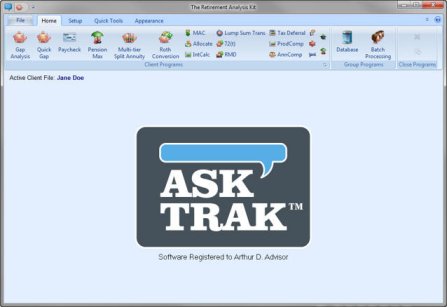
The Solution
Quick Start
Out of the box, ReportBuilder easily allows for getting up to speed quickly: integrated report previewer, data base access, charting, report explorer, an end-user report designer for those needing reporting solutions today, ReportBuilder provides a complete reporting solution.
Integration
While having all of the features that ReportBuilder provides to quickly get you up to speed, there are other important issues. One is tight integration: as TRAK has matured, there has been the need to provide tighter integration of reports within TRAK. ReportBuilder has made this transition easy on several levels.
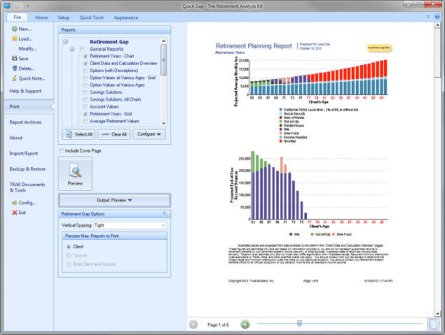
For the integration into the user interface, ReportBuilder appears as a natural part of TRAK with a modern ribbon interface. As shown above, the previewer is fully integrated. With ReportBuilder’s flexibility, the report order can be customized for an advisor’s preferences (e.g. the page order can easily be customized). And output can easily be sent to multiple formats (PDF, printer, and/or previewer) at the same time. Additionally, ReportBuilder allows for saving reports so that a copy of the report can view later. This integration has been a real bonus for helping our customers have features that they require.
Additionally, ReportBuilder’s report designer allows for designing professional reports. In designing a report, a graphical design recently asked “what are the limits of the reporting engine?” Our response was to design the perfect report and we would see what the reporting engine could do. The final report was almost identical to the initial goal. ReportBuilder provided the flexibly we needed.
Simplifying Complexities
Under the hood, a reporting tool needs to have a good object-orientated design. It needs to have its own scripting tool to best encapsulate report logic. And it needs to be flexible to help programmers be efficient with their time. ReportBuilder delivered.
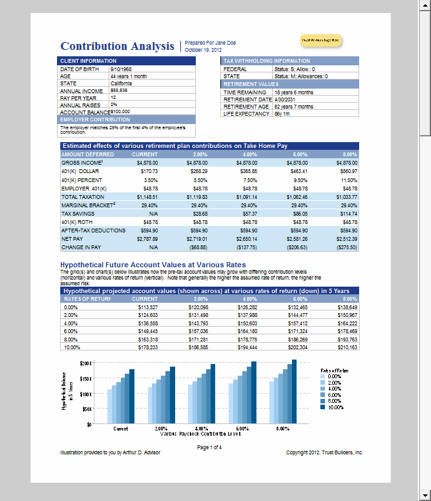
The object-orientated implementation of ReportBuilder makes navigating the class structures easy. Properties have names that would be expected, and this reduces the time it takes to learn to work with the product. Class structures can be derived from and extended to provide needed user interface changes or other functionality you tools require.
ReportBuilder’s scripting tool (Run-time Pascal, or RAP) provides run-time efficiencies. This keeps your application free from having to implement code for a specific report, and allows for complexities to reports otherwise not available. (The report shown above allows for the number of columns to vary, but always taking up the same width. This is implemented with RAP and pass-through functions).
ReportBuilder provides flexibility. Data can be accessed easily from their Data Access Development Environment (DADE), or directly through datasets, text files, or class structure allowing reports to access their data in a natural way. (No need to create datasets just for reports!).
Another area the flexibility of RAP was taken advantage of was with charts. TRAK includes a number of charts (using Steema’s VCL charting). Often, the difficulty in charting is maintaining two different charts: one in the user interface, and another one in the report. Because of the flexibility of ReportBuilder, TRAK maintains only one chart object, and the report in TRAK gets its image from the user interface. This flexibility has greatly reduced the amount of time needed to implement quality reports. Again, ReportBuilder delivered.
Support
Any complex software requires support, and Digital Metaphors’ support is top rate. The response time is quick, and this helps reduce programmer frustration. This is key in any third-party tools used by programmers.
A Complete Solution
ReportBuilder provides a complete solution for Delphi programmers. From getting started, to full integration into complex applications. ReportBuilder provides an excellent reporting option for any Delphi programmer!
Training Partner 2003
In May of 2004, GeoMetrix embarked on a development plan to replace its current reporting tool within the administrative module of Training Partner 2003. Training Partner 2003, the flagship product of GeoMetrix, is an enterprise learning management system used by utilities, media, governments, universities, law enforcement agencies, commercial trainers, hospitals, and Fortune 1000 companies around the world. After an extensive search and review of reporting systems available, GeoMetrix decided upon an end-user reporting solution using products from Digital Metaphors Corporation, Steema, and Gnostice.
The Challenge
GeoMetrix has been using a commonly available non-Delphi reporting tool within Training Partner. While acceptable when the application was first developed several years ago, the reporting engine within the administrative module (Win-32 desktop application) had a number of serious downsides:
Installation issues. Installation issues often occurred as a result of different applications installing different and sharing different versions of the reporting engine.
Size. The reporting engine required dozens of files and approximately 15MB+ for the run-time installation.
Performance. Even with a simple report, it could take five seconds just to load the engine, and often ten plus seconds to complete. Larger reports resulted in significant delays often causing users to thing that the application had hung and stopped functioning.
Database issues. The engine often required separate versions of the same report to operate against different SQL databases.
End-user designer. The engine did not include a run-time designer for end-users. A separate report designer had to be purchased by each client, which was not appropriate for many non-technical users.
Delphi integration. The engine included a Delphi VCL component, but the company dropped support for this in later versions. The recommended Active-X component was both large and slower.
Export options. Export options in the engine varied by version, and PDF and Word output often didn’t match the on-screen report.
As a result of these issues, a decision was made at the end of May 2004 to research the viability of using another reporting engine.
Finding a Solution
GeoMetrix examined numerous Delphi and non-Delphi reporting products: Report Smith, Quick Reports, FastReports, Rave Reports, ReportBuilder and others. We also considered several web-based systems.
ReportBuilder (and a few others) were recommended on the Borland Delphi forms, and GeoMetrix was able to download a free trial version quickly.
From the initial look at the documentation, sample reports, and the reporting components, it was clear that the product more than met the project requirements. The examples were extremely good (pointing out each of the capabilities of the system), written (.PDF) documentation was good, the (Delphi) help files were well designed, and the engine appeared extremely easy to integrate. ReportBuilder also offered a few other features that GeoMetrix didn’t expect such as integrated support for charting, a built-in macroing language (RAP), drill-down capability, and available source code. The product price also included royalty-free distribution of the engine and the designer.
Following the initial review, GeoMetrix not only concluded that replacing the current engine was viable, but that ReportBuilder would meet, and in many cases exceed, these goals. In June of 2004, GeoMetrix proceeded with purchasing ReportBuilder and implementation of the project.
Implementation
Adding ReportBuilder functionality to the Training Partner 2003 application took approximately one week. This included support for MDI windows, integration with the built-in reporting systems, support for the built-in macroing language (SaxBasic), COM access and invoking the designer.
The integration went extremely smoothly with the components cleanly designed and documented. Digital Metaphors staff answered any questions extremely quickly (same day) on their newsgroups.
Adding support for charting (using Steema’s charting component) and exporting to various formats (using a library from Gnostice’s eDocEngine) took GeoMetrix developers another week.
GeoMetrix staff also duplicated approximately eighty of the most complex reports already available in Training Partner – reviewing each using ReportBuilder. The process took one staff member two weeks, which included time to learn the new ReportBuilder report designer. A second staff member created approximately one hundred sample reports (as examples for clients) during the same period. Both staff members were extremely pleased at the simplicity and power of the designer.
End-user documentation for the new report designer was easily produced thanks to permission granted by Digital Metaphors to allow duplication of excerpts from their manuals.
Conclusion
GeoMetrix has been extremely satisfied with the results of the new built-in solution. In short: Installation issues. Installation issues are non-existent as ReportBuilder (as pure VCL code) is compiled into the application.
Size. GeoMetrix replaced 15MB+ of the previous engine’s libraries wile increasing the size of the application by less than 2MB – which includes the report designer.
Performance. Performance of the new reporting engine is at least 5-10 times that of the previous engine. Most reports now complete long before the previous engine could load.
Database issues. The database issues were solved. The same report runs correctly under all the databases supported by Training Partner: Oracle, MS SQL, and InterBase.
End-user designer. The report designer is built into the Training Partner application and is powerful and easy-to-use. Wizards are available within the system for creating reports.
Delphi integration. ReportBuilder is a pure VCL component with no libraries and the source code was included.
Export options. With the added eDocEngine engine from Gnostice, the application gained several export options, and PDF output is quick and almost perfectly matches the designed report.
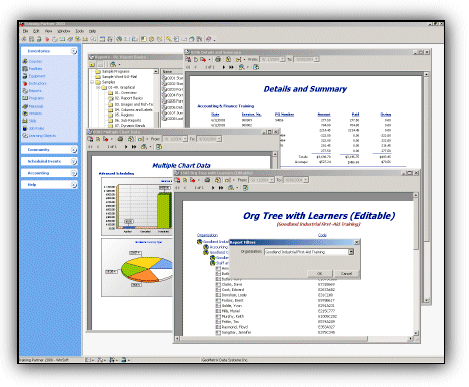
Training Partner 2003 – Displaying several ReportBuilder reports.
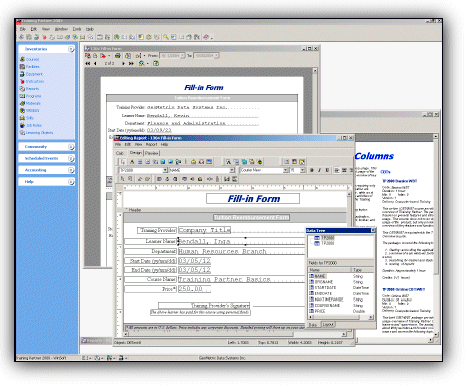
Training Partner 2003 – Editing a report using ReportBuilder.
Tickets.com
Tickets.com is a leading business-to-business ticketing solutions provider for live events, facilitating the sale of tickets by enabling venues and entertainment organizations with cutting edge software, retail outlets, kiosks, call centers, and interactive voice response (IVR) systems. Tickets.com also builds private label Ticketing GatewaysSM to enable entertainment organizations with e-commerce distribution platforms.
We serve the entire breadth of the entertainment industry, including professional sports teams, performing arts organizations, as well as many prestigious venues and arenas.
The Challenge
Tickets.com provides software solutions that capture a wealth of information about patrons and their ticket choices at the point-of-sale. Additional information is captured about customers and their preferences from various marketing activities conducted by each entertainment organization.
To be competitive in their marketplace, our customers need flexible, real-time access to the data in their customer databases. Historically, a fixed set of fully parameterized reports has been provided to users, but this approach does not provide our customers with the ultimate flexibility they are seeking.
The Product
ProVenue™ Reports is designed to allow our customers to write their own reports using state-of-the-art software and to enable a widespread distribution of those reports to personnel within their own organizations as well as targeted individuals outside their organization.
How ProVenue™ Reports Uses ReportBuilder
The reports are designed in a customized ‘Report Explorer’ application built with the ReportBuilder components provided by Digital Metaphors Corporation and deployed as a Win32 application.
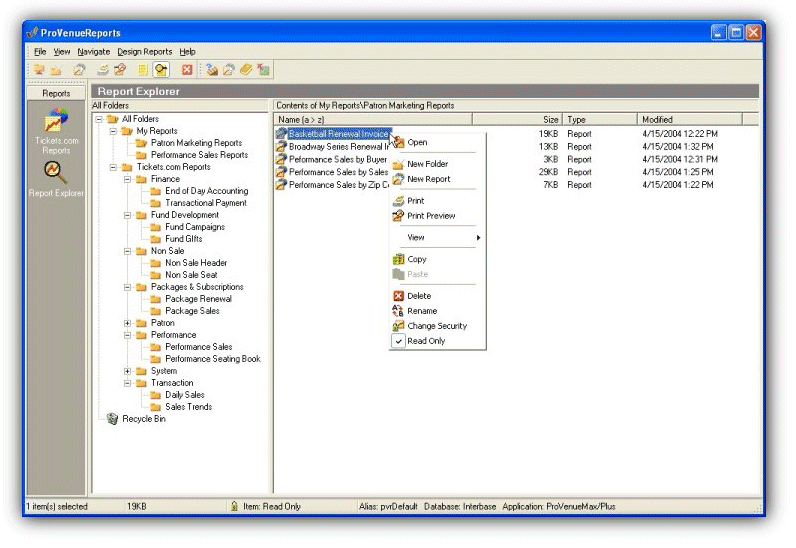
ReportBuilder provides us with a powerful, intuitive set of components that provide sophistication in the design of reports, and the ability for non-programming professionals to produce outstanding quality reports.
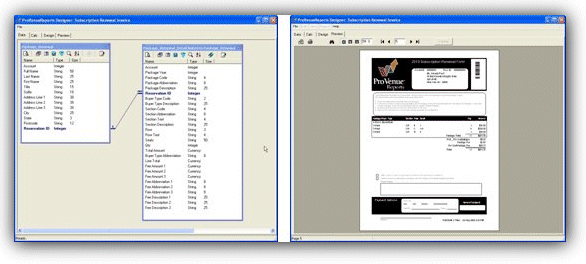
We also make use of the ReportBuilder Server components to enable the deployment of reports through a thin-client web browser. Deploying reports in a thin-client architecture eases the burden for the software installation considerably, and enables an entertainment organization to provide access to reports to people outside of their organization (a promoter or a producer for example).
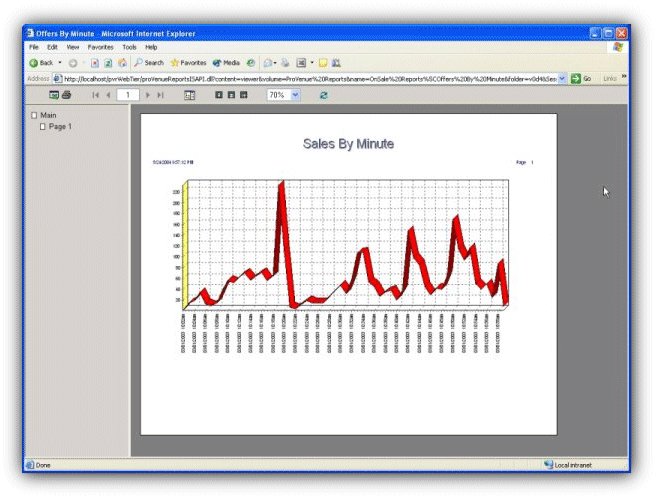
The Development
Building a world-class reporting product created a number of demands. Key factors in the development process included:
Flexibility – There were a number of challenges that were not easily met by most third party components:
· Our applications must provide an ability to retrieve data using complex queries and stored procedures. While the built-in query tools satisfy the required functionality in many cases, there are instances where the data relationships are too complex for the built-in tools. We have developed our own objects which respond to the Report Explorer events, executing our own data methods as appropriate.
· We must have an ability to build in a security framework that is consistent with the authentication used in our other applications. We are able to limit the folders and reports that are visible to end users using views that join the ‘folder’ and ‘items’ tables with our own security tables. We were able to extend the ‘Report Explorer’ functionality to include the ability to make folders and reports read-only based on security settings.
· We must have an ability to integrate our reporting application into our other applications, providing a consistent look-and-feel to our product offerings. Using the built-in examples provided by Digital Metaphors, we were able to ‘re-skin’ the application, adding our own visual elements.
Vendor Choice – Digital Metaphors produces high-quality reporting components and provides outstanding support for their product. The newsgroups provide a wealth of information and collaboration between the vendor and other developers. The company has always been extremely responsive to any support issues.
Cost of Deployment – Deploying reports via a thin-client web browser was an early requirement for the project. The ReportBuilder Server components are deployable at a very reasonable cost.
Conclusion
ProVenue™ Reports provides ticketing professionals the power and flexibility needed to compete successfully for the entertainment dollars of their customers. The ReportBuilder components from Digital Metaphors provide an ideal platform for building world-class reporting applications.